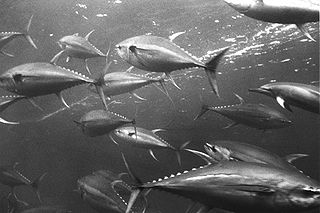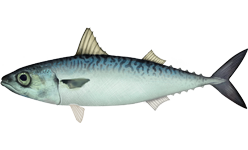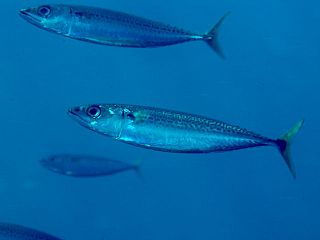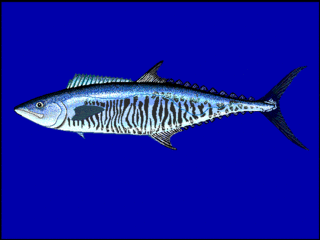
Mackerel is a common name applied to a number of different species of pelagic fish, mostly from the family Scombridae. They are found in both temperate and tropical seas, mostly living along the coast or offshore in the oceanic environment.

The mackerel, tuna, and bonito family, Scombridae, includes many of the most important and familiar food fishes. The family consists of 51 species in 15 genera and two subfamilies. All species are in the subfamily Scombrinae, except the butterfly kingfish, which is the sole member of subfamily Gasterochismatinae.

The Atlantic mackerel, also known as Boston mackerel, Norwegian mackerel, Scottish mackerel or just mackerel, is a species of mackerel found in the temperate waters of the Mediterranean Sea, the Black Sea, and the northern Atlantic Ocean, where it is extremely common and occurs in huge shoals in the pelagic zone down to about 200 m (660 ft). It spends the warmer months close to shore and near the ocean surface, appearing along the coast in spring and departing with the arrival of colder weather in the fall and winter months. During the fall and winter, it migrates out into deeper and more southern water, seeking warmer temperatures.

The double-lined mackerel, is a species of Spanish mackerel in the family Scombridae. This species is sometimes also called the scad mackerel.

The Atlantic horse mackerel, also known as the European horse mackerel or common scad, is a species of jack mackerel in the family Carangidae, the jacks, pompanos and trevallies. It is found in the eastern Atlantic Ocean off Europe and Africa and into the south-eastern Indian Ocean. It is an important species in commercial fisheries and is listed as a Vulnerable species on The IUCN Red List of Threatened Species.

The chub mackerel, Pacific mackerel, or Pacific chub mackerel is a species of fish in the tuna and mackerel family, Scombridae. This species of mackerel closely resembles the Atlantic chub mackerel.

The blue mackerel, also called Japanese mackerel, Pacific mackerel, slimy mackerel or spotted chub mackerel, is a fish of the family Scombridae, found in tropical and subtropical waters of the Pacific Ocean from Japan south to Australia and New Zealand, in the eastern Pacific, and the Indo-West Pacific: the Red Sea, the Persian Gulf, the Gulf of Oman and the Gulf of Aden, in surface waters down to 200 m (660 ft). In Japanese, it is known as goma saba. It typically reaches 30 cm (12 in) in length and 1.4 kg (3.1 lb) in weight.

The butterfly kingfish is an ocean-dwelling ray-finned bony fish in the mackerel family, Scombridae – a family which it shares with the tunas, mackerels, Spanish mackerels, and bonitos. Unlike the 50 species from those four tribes, however, this species is unique in that it is the only scombrid to be classified apart from the rest, into the subfamily Gasterochismatinae and genus Gasterochisma.

The narrow-barred Spanish mackerel is a mackerel of the family Scombridae found in a wide-ranging area centering in Southeast Asia, but as far west as the east coast of Africa and from the Middle East and along the northern coastal areas of the Indian Ocean, and as far east as the South West Pacific Ocean.

Scomber is a genus of fish in the family Scombridae living in the open ocean found in Atlantic, Indian and Pacific Ocean. The genus Scomber and the genus Rastrelliger comprise the tribe Scombrini, known as the "true mackerels". These fishes have an elongated body, highly streamlined, muscular and agile. The eyes are large, the head is elongated, with a big mouth provided with teeth. They have two dorsal triangular fins, with some stabilizing fins along the caudal peduncle. The basic color is blue-green with a silvery white belly and a darker back, usually black mottled.
The broadbarred king mackerel is a species of fish in the family Scombridae found in tropical waters of the western Pacific, along the northern coast of Australia and the southern coast of Papua New Guinea, from Shark Bay, Western Australia to northern New South Wales, in waters from the surface down to 100 m (330 ft). Specimens have been recorded at up to 120 cm in length, and weighing up to 10 kg. They are pelagic predators, feeding on small fishes such as sardines and herring.

The Kanadi kingfish is a species of ray-finned bony fish in the family Scombridae, the mackerel family. Also known as the Kanadi seerfish, queen mackerel, or spotted mackerel, it is found in subtropical waters of the western Indian Ocean, Seychelles, Kenya and Zanzibar to South Africa and along the west coast of Madagascar. Kanadi kingfish commonly occur in depths of 50 to 200 m. Specimens have been recorded at up to 120 cm (47 in) in length, and weighing up to 12.5 kg (28 lb). They feed mainly on small fishes such as anchovies and clupeids, squids, and mantis shrimps.

The torpedo scad, also known as the hardtail scad, finny scad, finletted mackerel scad or cordyla scad, is a species of moderately large marine fish classified in the jack and horse mackerel family, Carangidae. The torpedo scad is distributed throughout the tropical Indo-Pacific region, ranging from South Africa in the west to Tonga in the east, extending to Japan in the north and Australia in south. It is a schooling pelagic fish which occupies the surface layers of both inshore and offshore oceanic waters. The torpedo scad is easily identified by both its 'torpedo' shaped body and a series of detached finlets at the rear of both the dorsal and anal fins. The largest recorded individual was 80 cm long and weighed 4 kg, although it is more common at lengths less than 40 cm. It is a predatory species, taking a variety of fish, cephalopods and crustaceans by both active and filter feeding. There is a shift in diet as the species grow; however fish is the dominant prey in all size classes. Torpedo scad reach sexual maturity at 22 cm in females and 26.4 cm in males, with spawning occurring between March and July in India, where significant research into larval growth and morphometrics has been carried out.

The Indian mackerel is a species of mackerel in the scombrid family of order Perciformes. It is commonly found in the Indian and West Pacific oceans, and their surrounding seas. It is an important food fish and is commonly used in South and South-East Asian cuisine.

Rastrelliger is a mackerel genus in the family Scombridae. The three species of Rastrelliger together with the four species of Scomber comprise the tribe Scombrini, known as the "true mackerels".

The Scombrinae are a subfamily of ray-finned bony fishes in the family Scombridae. Of the 51 species in the Scombridae, 50 are in Scombrinae – with the sole exception being the butterfly kingfish, which is placed in the monospecific subfamily Gasterochismatinae.

Scombrini, commonly called the true mackerels, is a tribe of ray-finned bony fishes in the mackerel family, Scombridae – a family it shares with the Spanish mackerel, tuna and bonito tribes, plus the butterfly kingfish.
Microcotyle inglisi is a species of monogenean, parasitic on the gills of a marine fish. It belongs to the family Microcotylidae. It was first described and illustrated based on 5 specimens from the gills of the Indian mackerel Scomber microlepidotus (Scombridae) off Odisha, India..
Microcotyle korathai is a species of monogenean, parasitic on the gills of a marine fish. It belongs to the family Microcotylidae. It was first described and illustrated based on 6 specimens from the gills of the Indian mackerel Scomber microlepidotus (Scombridae) off Odisha, India..















